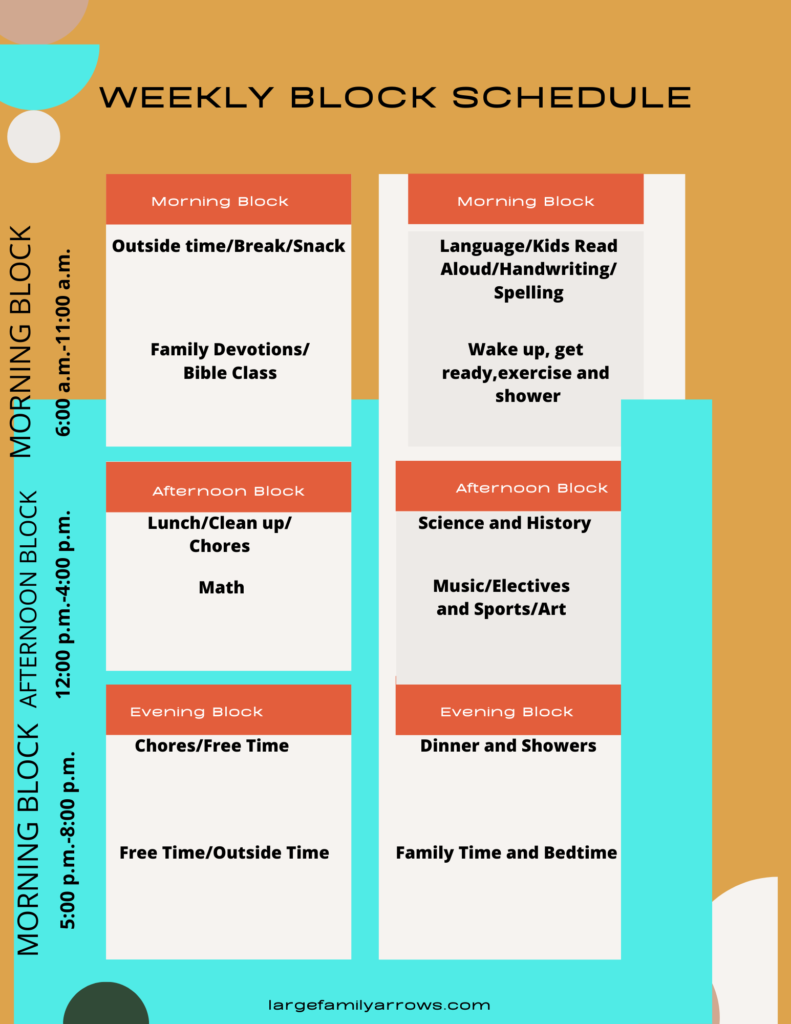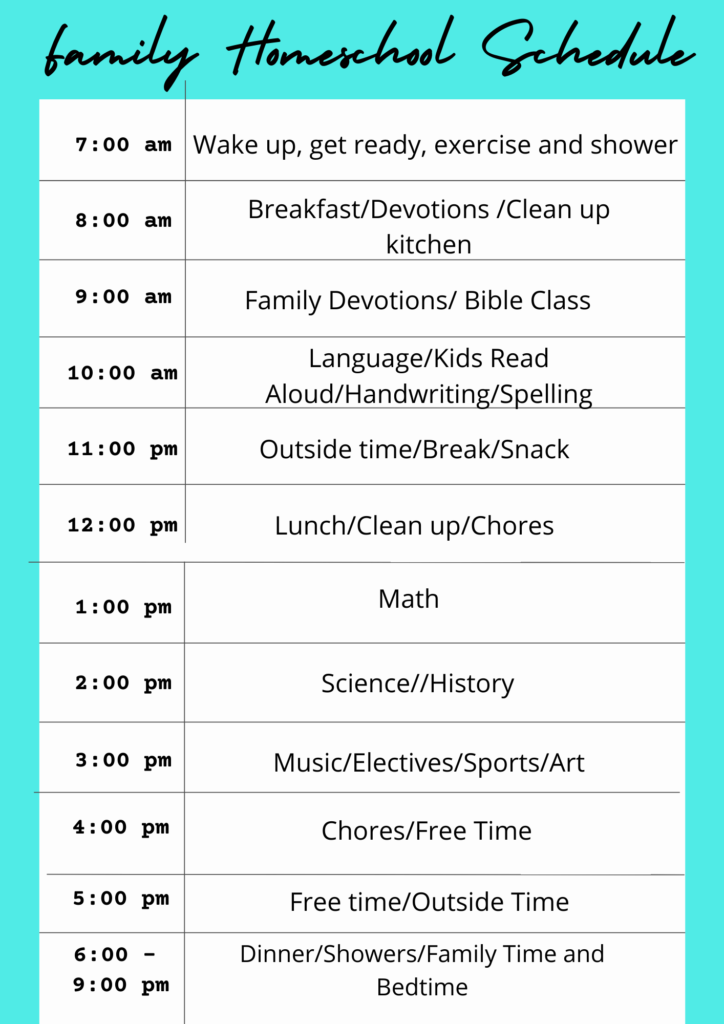
In this blog post, we will discuss some tips and tricks for creating a working homeschool schedule that will help make your life a little bit easier!
BLOCK SCHEDULES VS HOURLY SCHEDULES
When creating a homeschool schedule, one of the first decisions you will have to make is whether you want to use a block schedule or an hourly schedule to plan your homeschool day. A block schedule is where you plan the specific things that need to take place in your morning block, afternoon block, and evening block. For example, getting up and getting dressed would be in your morning block. However, perhaps you want to do your personal devotions, exercise, make your bed, do some laundry and if you work from home, you may do some work during this time. Many times this block takes place when the children are still sleeping, When everyone else wakes, this block would also include breakfast and beginning your school.
Your afternoon block might include lunch, chores, planning your dinner, running errands, or paying bills. It might also include making phone calls and checking emails. Of course, if your kids haven’t finished all their school. Then helping them with school would probably be in this block.
The evening block is going to have dinner, showers, and maybe time that you do things together with your family. You might also pick out your clothes for the next day, maybe get some more housework or business work if that’s something that is in your schedule. Lastly spending time with your husband would be in this block.
This is an example of blocking out your time or a block schedule.


Block Scheduling 101: What It Is, Why It Works And How To Get Started
A regular hourly schedule or planner is just that. You would schedule what you are needing to be doing, and in the hour that this needs to take place.
Such as 7:00 am you wake up, get ready, exercise, and take a shower. Then at 8:00 you would eat breakfast, do devotions, clean up your kitchen, and so forth. Each hour you would move on to something different until you have accomplished each thing you need to be doing for the day.
There are pros and cons to both methods. A block schedule can be helpful in that it allows you and your students the flexibility of planning their day but, being able to make changes if things arise.
An hourly schedule isn’t as flexible. You need to be changing your day, all day, and on the hour.
For me, I have tried both types of schedules. Now what works for me, may not work for you.
I found that trying to follow an hourly schedule made me feel stressed and overwhelmed in trying to keep up with what me and the kids were supposed to be doing all day.
A block schedule has worked better for me because I know what things need to happen within a certain block. If something comes up and we get off our schedule, we can always jump right back in when we can because we can check the block that we are in.
In order to decide which is best, here are some tips to get you started.
– Make a list of your family’s priorities and try to fit homeschooling into that timeframe.
– Decide what type of homeschool schedule will work best for your family- block or hourly
– Choose a curriculum that is interesting to your child and fits well with the type of homeschool schedule you have chosen.
– Create a weekly or daily routine and stick to it as closely as possible.
– Include breaks and downtime in your homeschool schedule to allow for some relaxation and family time.
– Use a schedule or planner to help keep you organized and on track.
Both block and hourly homeschooling schedules have their own benefits and drawbacks. You will need to decide what is best for your family.
When creating your homeschool schedule, be sure to also include breaks for rest and relaxation. This can help keep everyone in the family happy and motivated!
DECIDE HOW YOU WILL PLAN YOUR HOMESCHOOL SCHEDULE
When creating your homeschool schedule, it can be helpful to plan your days, weeks, or months ahead of time. This will help keep you on track and prevent homeschooling from becoming overwhelming. When planning your schedule. Having not only a daily schedule but planning even monthly can help you plan for those times that events will come up that will affect class time.
For example, if you have a vacation planned around Christmas time, you can plan your daily and monthly schedule around the time you will be out of town. Or if you have family coming in the middle of the school term, then you can already have that time planned in advance. Homeschooling is very flexible and you have options of planning classes around life events.
THE BENEFITS OF YEAR-ROUND HOMESCHOOLING: PROS AND CONS
ALTERNATE ON SCHOOL SUBJECTS
It can be helpful to alternate school subjects. If your children are older, doing Math and Science on one day then doing Language Arts and History on another day might be an option. . Following this kind of schedule is more like the college schedule and will get your older kids into the hang of attending classes that way.
over-commit your day. This will help prevent homeschooling from becoming overwhelming.
It can be helpful to have a designated “read aloud” time each day where you all read together. This can be a great opportunity for family bonding and discussion!
CHORE TIME
In order to make homeschooling work, it is important to designate time for chores. This will help keep your home clean and organized.
It can be helpful to have a designated “chore time” each day where everyone in the family helps out. This can be a great way to teach your children responsibility!
MAKE SURE TO SCHEDULE BREAK TIME
When homeschooling, it is important to schedule break time. This can assist in making homeschooling less daunting.
It can be helpful to have a designated “break time” each day where you can relax and rejuvenate. This can help keep you energized for the rest of the day!
SCHEDULE FREE PLAYTIME
You know they say all work and no play makes you dull. So just remember moms, the kids, and the moms need downtime. It can get easy to be so focused on getting things done, that we forget our kids need breaks and so do we.
You know how it is moms, we always have things to do and sometimes we need reminding to slow down and smell the roses so to speak. We where a lot of hats and we have a lot of responsibilities, taking care of our kiddos and making sure they get their education.
“It’s important to give everyone some breaks including yourself mom.”
PLAN SUBJECTS THAT CAN BE DONE WITH MULTIPLE AGES
When homeschooling, it can be helpful to plan subjects that can be done with multiple ages. This will help when teaching several children.
Unit studies are a great way to do this. Some unit studies are designed with different age groups in mind. They will have lessons for the younger kids and then the lessons can be taken deeper for older students. This is a great way to do classes like History together. This can help when planning your homeschool schedule.
ALWAYS BE FLEXIBLE
When homeschooling, it is important to be flexible. Always being flexible allows events to come up in life.
For example, if your child is struggling with a particular subject, it may be necessary to adjust your homeschool schedule. This will allow time for your student to be able to go over a topic again until he or she has a good understanding of a lesson. Instead of pushing through when that student isn’t ready.
Moreover, if someone is sick, has an appointment or something comes up that you didn’t plan for. If you keep your homeschool schedule flexible. It won’t get too behind or overwhelmed thinking you are behind. You can always jump back on your planner and see where you need to continue at.
USE A HOMESCHOOL PLANNER TO ORGANIZE LESSONS
When homeschooling, it can be helpful to use a homeschool planner to organize your lessons. This can include space for you to track what has been completed, what needs to be done next, and how long each lesson should take.
This can help keep you on track and help you keep working toward the goal.
IN CLOSING…
When planning your homeschool schedule, it is important to be flexible and to always keep in mind what works best for your family. Also, be sure to include breaks for meals, rest, and play. Everyone will be happier and more driven when they know that everyone else in the family is being rewarded for their hard work!
Download your free schedules today by subscribing. Please share and subscribe.
